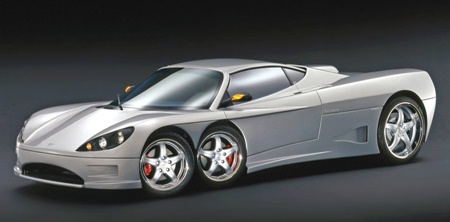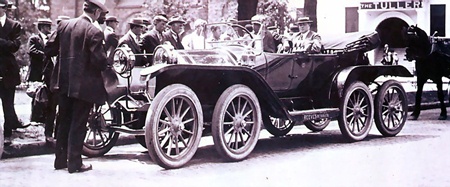The motoring world is going ga-ga again over six wheels. An Italian group called Covini Engineering has partnered with PMI SpA to finally unveil the production version of the six-wheeled Covini C6W Supercar at the Racing Professional Motor Show in Bologna.
Now this concept is far from new and has been around since JC was in short pants and played for Bethlehem United, despite what the press releases from Covini Engineering would have you believe.
 Covini C6W
Covini C6W
According to Covini the six-wheeled Covini C6W is powered by a 4.2-liter Audi-sourced V8 delivering its 440 bhp and 346 lb-ft torque driving through a six-speed manual gearbox.
Covini says it was “inspired by the Tyrell P34 Formula One car of the seventies. The Tyrell was not the only F1 development to include the possibility of four front wheels and it was only a rule change that prevented the world’s most watched sporting event from spawning a whole new set of engineering solutions.”
According to Covini, the rationale for four front-wheels was first detailed in a landmark Ford concept car shown at the World Fair in 1963. This was not the first by a long chalk. The earliest six-wheeler dates to 1903 when Albert P. Broomell of York, Pennsylvania, a manufacturer of steam heating equipment, first designed his Pullman. Broomell figured a two-cylinder engine would be enough to push his car around through a center axle, freeing both the front and rear axles for steering duties. Something Honda took on many years later, with their four wheel steering but without the central axle. While it probably had an incredibly tight steering radius, the fact that it was underpowered and overweight was apparent from Broomell’s subsequent reconfiguration of the car with a four-cylinder engine and sans one axle. Broomell later found success with his more conventional four-wheeled Pullman, built from 1905-1917.
 Octoauto 1911
Octoauto 1911
Charles T. Pratt of Frankfort, New York, also produced a six-wheeled car. Like Reeves, he was also an industrialist, the owner of the Pratt Chuck Works. His six-wheeler was set up to use both the forward and center axles for steering and the aft axle for propulsion, powered by an unidentified 75 hp engine. Its wheelbase – presumably measured between front and rear axles – was 168 inches.
Pratt told the press of the day that he only built it for his own use, but he did patent his invention (842,245 – Running Gear for Automobiles) in January 1907 and followed up with a second patent (888,737 – Automobile Running-Gear) in May 1908.
Now if six wheels was better, how about eight? The Octoauto actually used eight wheels – four steering up front, four out back – and was based on a 1910 Overland. Unable to attract customers in 1911, they removed one of the steering axles from the Overland to create the Sextoauto, and followed that with another six-wheeled automobile based on a Stutz chassis. The Sextoauto, with a $5,000 price tag (about $115,000 today), did not sell either.
The high price tag of these six wheelers has continued through to today with an Italian automotive web site suggesting a price in the vicinity of around US $400,000 for the 300 km/h rear-wheel-drive C6W.
Again according to Covini, the numerous benefits of four front wheels includes significantly better braking, cornering and “feel”. That’s too high a price I believe and I expect the Covini to go the way of the Sextauto too.




